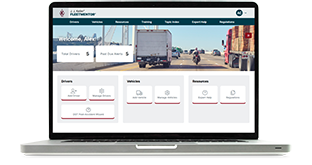Transport Safety Editor — J. J. Keller & Associates, Inc.
How to Survive an FMCSA Audit
A successful FMCSA audit depends on knowing what to expect and having all required documentation in place. Read more about how audits are handled.
Published On: 08/16/2024


Written by:
Kathy Close
The Federal Motor Carrier Safety Administration (FMCSA) conducts thousands of audits each year to enforce the motor carrier safety and hazardous materials regulations. The targets of these audits are interstate motor carriers as well as in-state-only carriers that transport hazardous materials. Surviving an FMCSA audit depends on knowing the types of audits being conducted, knowing what to expect during an audit (and preparing for it!), and having all required documentation in place.
FMCSA audits, sometimes called “DOT audits” or “investigations,” come in three main varieties:
- OFFSITE FOCUSED INVESTIGATIONS target a specific area of compliance, such as hours of service. The motor carrier sends its compliance records to the FMCSA regional office for review. This type of investigation does not result in a safety rating.
- ONSITE FOCUSED INVESTIGATIONS also target a specific area of compliance, but enforcement personnel will perform the audit at the motor carrier’s principal place of business (as identified on the USDOT registration). This type of investigation also does not result in a safety rating.
- ONSITE COMPREHENSIVE INVESTIGATIONS address all aspects of a motor carrier’s operation and take place at the motor carrier’s principal place of business. This type of investigation results in a safety rating.
Safety Ratings
The FMCSA will only assign a safety rating to a motor carrier after performing an onsite comprehensive investigation. The onsite comprehensive investigation contains the compliance review model.
Appendix B to Part 385 details the method used in the compliance review to arrive at one of the following three possible safety ratings:
- SATISFACTORY. The motor carrier’s safety management controls are considered functioning and adequate.
- CONDITIONAL. The motor carrier does not have adequate safety management controls in place to ensure compliance, and the motor carrier has to make some changes to show it is working on the problem areas.
- UNSATISFACTORY. The motor carrier does not have adequate safety management controls in place to ensure compliance, and its violations are to such a degree that the motor carrier is prohibited from operating commercial motor vehicles.
Note that the FMCSA has proposed to change the way it issues safety ratings. Rather than relying solely on comprehensive reviews, the agency would like to use roadside inspection data, data collected during investigations (of any type), or a combination of the two to arrive at a rating. Under this proposed system, carriers would be rated as either “fit” or “unfit” to continue operating.
New Entrant Safety Audits
In addition to the investigations noted earlier, the FMCSA reviews the compliance of new entrants through a safety audit. A “new entrant” is a motor carrier that applies for United States Department of Transportation registration (i.e., a USDOT number) in order to operate in interstate commerce. New entrants are given a “new entrant registration” status and their safety management practices are monitored for an 18-month period.
The FMCSA will perform a new entrant safety audit within 12 months for a property carrier and 3 months for a passenger carrier. The compliance documents and processes examined for new entrants are the same as for those companies that have been in business for years. The safety audit is used to monitor and assist the new carrier in establishing a sound safety program from the onset. It is for educational purposes and will not result in a safety rating. However, if inadequate basic safety management controls are found during a safety audit, the new entrant will be unable to continue operating in interstate commerce.
Audit Preparation
The best defense against a negative FMCSA audit is preparation. And one of the best tools to accomplish that is J. J. Keller’s FleetMentor® System. This cloud-based compliance tool provides you with a full suite of fleet management resources, including the ability to audit your operations to identify risk areas and develop corrective action plans.
For a FREE FleetMentor trial, call 877.595.1157 or visit FleetMentor.com.

J. J. Keller® FleetMentor® Service
The J. J. Keller® FleetMentor® System serves and supports thousands of transportation professionals every day with problem-solving tools and guidance. Whether you have one truck or a thousand, a fleet of commercial motor vehicles or F-150s, or haul goods or provide services — FleetMentor has you covered.
You may also enjoy the following articles:
Sign up for our newsletter!
We'll help you stay on top of regulations, best practices, and fleet industry news. Sign up to receive a monthly email notification with links to our most recent blog articles, free resources, and event invites.